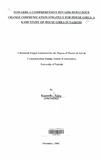| dc.description.abstract | In conceptual ising this study, three important aspects were considered. Firstly, in spite of the determined efforts to confront the AIDS pandemic, HIV infection levels still remain high. Secondly, no studies have been conceptualised to give insight into sexual behaviours and practices of house girls as they apply to a range of contexts. Thirdly, for a Behaviour Change Communication (BCC) programme to be effective, it requires that adequate and accurate data on the audience be first provided.
The objectives of this study was therefore to assess the house girls' knowledge, attitudes, beliefs and practices (KABP) in relation to HIV I AIDS, and to evaluate their communication habits with a view to recommending strategies for a BCC programme.
The literature review comprised information on house girls in relation to HIV I AIDS from the global perspective to the situation in Kenya. The study was founded on various communications and behaviour theories, mainly theory of reasoned action (TRA) , health belief model (HBM), diffusion of innovation model and the conventional theory of persuasion.
The study was conducted within Nairobi Province where 106 house girls were interviewed. They were selected from Loresho, South B-Plainsview, Buruburu Phase III, Umoja Phase I and Kariobangi North residential areas to represent the socio-economic variations in Nairobi. Qualitative data was collected by way of a focus group discussion held at Sinaga Women and Child Labour Resource Centre, Kariobangi, and key informant interviews where 10 people were interviewed. These were one church leader involved in the rehabilitation of young women from poor families, a former house girl, and two employers, employers' children, social workers and house girls. Data was
analysed through a computer programme SPSS, interpreted through descriptive statistics and presented in form of tables, graphs and pie charts.
Major findings indicated that most house girls are aged about 18 years and not married, and may keep several sexual partners within a year. Their jobs are very unstable and earn as little as KSh200. Virtually all house girls have only acquired primary school education.
Media attendance is high, especially for radio. The most popular programmes in both radio and TV are those aired in a mixture of Kiswahili and English, and Kikuyu languages, are humorous and require little cognitive involvement. Radio also scored highly both as a source of HIV / AIDS information and credibility. Other credible sources were fellow house girls, church leaders and TV.
Comprehensive knowledge on HIV / AIDS is low. There are misconceptions on HIV infection and condoms. Although many house girls know VCT services are cheaply available, very few know their serostatus. Most house girls are sexually active, but few consider themselves at risk of HIV infection. General rights awareness is very low. Only 6 percent of respondents could be described as fully aware of their rights pertaining to physical and sexual abuse.
In view of the findings, this study recommended a HIV / AIDS communication strategy for house girls in Nairobi. The general objectives should be to educate the house girls on the correct methods of HIV infection prevention, skills on condom use and sex negotiation, importance of HIV testing and basic human rights. It proposed use of radio, TV and simple print materials as channels of communication, but notes that interpersonal communication would be the most effective mode. Kiswahili should be the language of
communication. The study recommended a holistic approach in line with Communication for Social Change, an approach to communication that focuses less on changing individual behaviours and more on empowering communities to tackle the underlying issues of discrimination, poverty and marginalisation.
The study suggests that further research including national HIV / AIDS/STDs behavioural surveillance survey on house girls be done, and a national HIV / AIDS BCC strategy is developed. Free education programme should be extended beyond primary school, relevant laws and policies enacted, and that house girls are mobilised through a trade union.
This study also notes that research results are seldom implemented in HIV / AIDS prevention and care programmes. The key challenge is therefore to establish strong links between research, policy and planning. This study advises that the recommended communication strategy is adopted, with necessary adjustments, and taken through other stages of messages development and pre-testing, implementation, monitoring and evaluation, and that continuity and sustainability of the intervention is ensured. | en |

